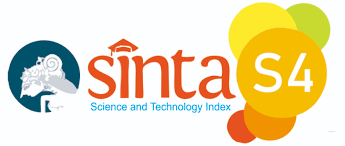Kajian kualitas air dan kondisi sanitasi sumur gali di Lingkungan Permukiman Kelurahan Kampung Bugis, Kota Tanjungpinang
DOI:
https://doi.org/10.32734/trophico.v5i1.20685Keywords:
Clean Water, Dug Wells, Water Quality, Sanitation of Dug WellsAbstract
The use of protected dug wells in Tanjungpinang City reached 29.84%, while the use of unprotected dug wells in the community reached 1.40%. At the research location, it was found that the distance to the source of contamination (septic tank) was less than 15 meters, did not have a cover, buckets and rope were placed on the floor of the well, allowing contamination. The purpose of the study was to determine the description of water quality and sanitation of dug wells in Kampung Sei Nyirih RT 002 RW 005 Kelurahan Kampung Bugis. This type of research was descriptive with a total of 20 samples (physical, chemical, microbiological, and sanitation of dug wells). The research instruments used TDS meter, pH meter, Dry Compact EC, and checklist sheet. Univariate analysis was used in this study. A total of 15% of samples did not meet odor, color, and taste requirements. Examination of water chemical quality as many as 60% of samples did not meet the requirements of the pH parameter of clean water. In the E. Coli parameter, 100% of the samples did not meet the requirements. The results of the sanitary inspection of dug wells showed that 5% of wells were very high risk, 55% of wells were high risk, 30% of wells were medium risk, and 10% of wells were low risk. It is expected that the community in the research location to pay more attention to sanitary conditions, physical quality of water, construction of clean water sources, namely dug wells, and cooking to boil clean water sources that will be consumed
Downloads
References
Alfala, S., & Nuraini, C. (2024). Partisipasi Masyarakat dalam Pengelolaan Sumber Daya Air Berkelanjutan di Karo. PROSEMNASPROIT : Prosiding Seminar Nasional Ilmu Teknik, 1(2), 1–13. https://prosiding.aritekin.or.id/index.php/PROSEMNASPROIT
Amnan, A., & Naelasari, D. N. (2023). Pengaruh Saluran Pembuangan Air Limbah (SPAL) terhadap kualitas fisik air sumur gali di Desa Telagawaru Wilayah Kerja Puskesmas Labuapi. Jambura Journal of Health Sciences and Research, 5(2), 512–518. https://doi.org/10.35971/jjhsr.v5i2.18364
Aneta, R., Umboh, J. M. L., & Sondakh, R. C. (2021). Analisis tingkat kekeruhan, Total Dissolved Solids (TDS) dan kandungan Escherichia coli pada air sumur di Desa Arakan Kecamatan Tatapaan. Jurnal KESMAS, 10(4).
Azhari, A. R., Irawati, S., & Sari, M. (2025). Akses terhadap air bersih dan sanitasi layak dalam pencegahan penyakit tropis terabaikan : sebuah tinjauan sistematis. Jurnal Ners, 9(3 SE-Articles), 3815–3824. https://doi.org/10.31004/jn.v9i3.45501
Badan Pusat Statistik. (2023). Propinsi Kepulauan Riau dalam Angka. https://www.bps.go.id/id/publication/2022/02/25/0a2afea4fab72a5d052cb315/statistik-indonesia-2022.html
Baktiar, S., Sahdan, M., & Setyobudi, A. (2022). Gambaran konstruksi dan letak sumur gali dengan kandungan pestisida dalam air sumur gali di area persawahan Kelurahan Oesao, Kabupaten Kupang. Media Kesehatan Masyarakat, 4(1), 100–107. https://doi.org/10.35508/mkm
BPS Kota Tanjungpinang. (2023). Badan Pusat Statistik Kota Tanjungpinang BPS-Statistics of Tanjungpinang Municipality.
Dewantoro, W., & Sitaresmi, D. T. (2022). Potensi dan permasalahan penyediaan air bersih di Kelurahan Kariangau menggunakan root cause tree analysis. Region: Jurnal Pembangunan Wilayah dan Perencanaan Partisipatif, 17(1), 167.
Lestari, K.D., Sulistio, I., & Ferizqo, F.A. (2021). Kualitas Sumur Gali Ditinjau dari Cemaran Sungai di Desa Tropodo Kecamatan Krian Kabupaten Sidoarjo Tahun 2021. Jurnal Higiene Sanitasi, 1(32), 8–16.
Aryana, I.K., & Sudiadnyana, I.W. (2023). Tingkat risiko pencemaran berhubungan dengan kualitas air sumur penduduk Kota Denpasar. Jurnal Kesehatan Lingkungan, 13(2).
Lestari, I. L., Singkam, A. R., Agustin, F., Miftahussalimah, P. L., Maharani, A. Y., & Lingga, R. (2021). Perbandingan kualitas air sumur galian dan bor berdasarkan parameter kimia dan parameter fisika. BIOEDUSAINS: Jurnal Pendidikan Biologi dan Sains, 4(2). https://doi.org/10.31539/bioedusains.v4i2.2346
Munfiah, S., Nurjazuli, N., & Setiani, O. (n.d.). Kualitas fisik dan kimia air sumur gali dan sumur bor di wilayah kerja Puskesmas Guntur II Kabupaten Demak. Jurnal Kesehatan Lingkungan Indonesia, 12(2). https://ejournal.undip.ac.id/index.php/jkli/article/view/8553
Pitojo, S., Purwantoyo, & Eling, S. (2019). Deteksi pencemar air minum. Semarang: CV.Aneka Ilmu.
Putri, A. D., Suksmerri, S., Riviwanto, M., Mahaza, M., & Darwel, D. (2023). Sumur gali gambaran risiko pencemaran dan kandungan coliform air sumur gali di Kenagarian Gurun Panjang Kapuh Kecamatan Koto XI Tarusan. Jurnal Kesehatan Lingkungan Mandiri, 2(1). https://doi.org/10.33761/jklm.v2i1.705
Rahayu, P., Joko, T., & Dangiran, H. L. (2019). Hubungan faktor risiko pencemaran sumur gali dengan kualitas bakteriologis di lingkungan pemukiman RW IV Kelurahan Jabungan Kota Semarang. Jurnal Kesehatan Masyarakat,7 (3). https://ejournal3.undip.ac.id/index.php/jkm/article/view/27372
Razali, R., & Ningsih, I. (2023). Analisis kualitas air sumur gali sebagai sumber air bersih dan air minum di Kelurahan Tiban Lama. Jurnal Kesehatan Ibnu Sina (J-KIS), 4(2), 1–13.
Souisa, G., & Janwarin, L. Y. (2018). Kualitas sumur gali di Dusun Wahakaim. HIGEIA (Journal of Public Health Research and Development), 2(4). https://doi.org/10.15294/higeia.v2i4.23632
Suryani, F., EG, E. G., & MU, M. U. (2022). Analisis kualitas fisik dan risiko kontaminasi terhadap kandungan bakteriologis pada sumur gali di wilayah kerja Dinas Kesehatan OKU 2021. Jurnal Kesehatan Saelmakers PERDANA, 5(1). https://doi.org/10.32524/jksp.v5i1.393
Syafarida, U. Y., Jati, D. R., & Sulastri, A. (2022). Analisis hubungan konstruksi sumur gali dan sanitasi lingkungan terhadap jumlah bakteri coliform dalam air sumur gali (Studi kasus: Desa PAL IX, Kecamatan Sungai Kakap). Jurnal Ilmu Lingkungan, 20(3), 437–444. https://doi.org/10.14710/jil.20.3.437-444
Zulfikar, Z., Putri, R., & Aditama, W. (2020). Hubungan risiko tercemar sumur gali dengan keberadaan bakteri Escherichia coli di Gampong Daroy Kameu Kecamatan Darul Imarah Kabupaten Aceh Besar Tahun 2017. Sanitasi: Jurnal Kesehatan Lingkungan, 11(2), 56–64. https://doi.org/10.29238/sanitasi.v11i2.940
Downloads
Published
How to Cite
Issue
Section
License
Copyright (c) 2025 Tropical Public Health Journal

This work is licensed under a Creative Commons Attribution-ShareAlike 4.0 International License.
















